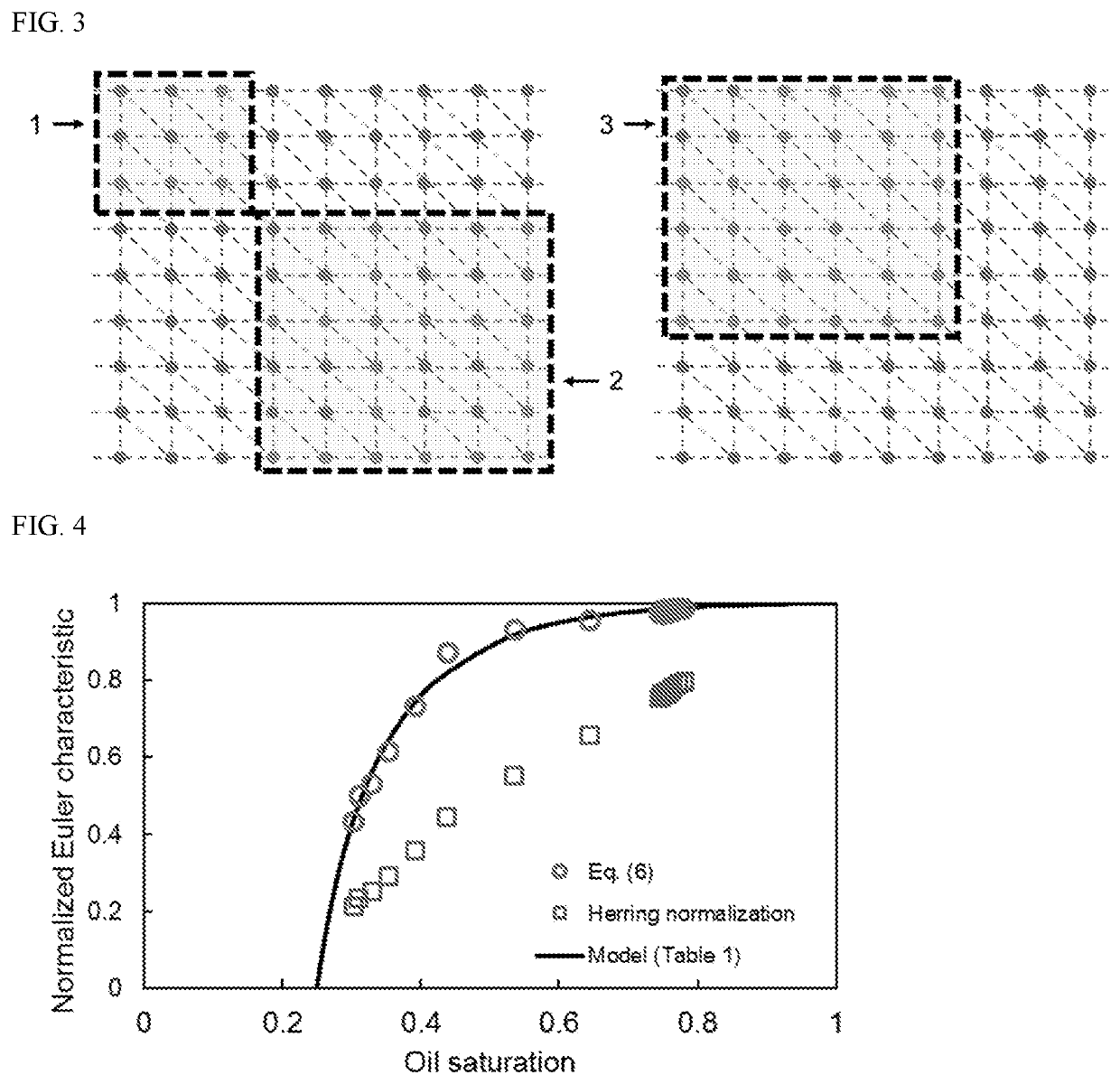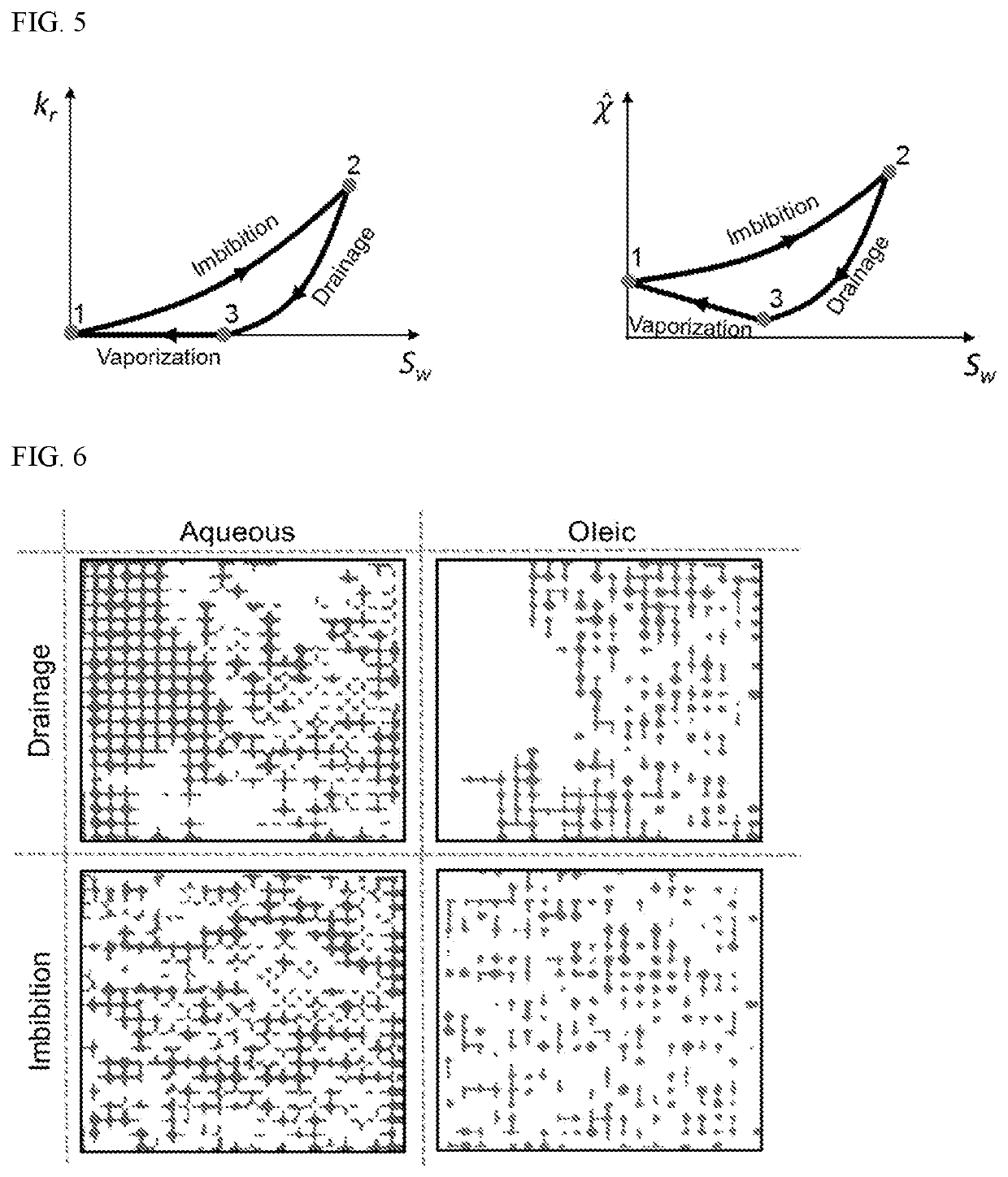Computer system and method for predicting petrophysical properties in a fluid having one or more phases in porous media
a computer system and porous media technology, applied in the field of composition simulator for recovery predictions, can solve the problems of incomplete simulation, significant reduction of time-step size, inaccuracy of recovery estimates, etc., and achieve the effects of improving composition simulation, improving accuracy, and improving accuracy
- Summary
- Abstract
- Description
- Claims
- Application Information
AI Technical Summary
Benefits of technology
Problems solved by technology
Method used
Image
Examples
case 1
[0126] Euler Characteristics Tuned to Micromodel Images
[0127]Conventionally, the relative permeability in glass micromodels has been measured for different wettability conditions. The present disclosure used micromodel images and relative permeabilities for water-diesel experiments to tune the EoS relative permeability model. First, the image-processing toolbox of Matlab™ is used to calculate the phase saturations and Euler characteristics. The phase distribution results after image processing are shown in FIG. 6.
[0128]The calculated values of Euler characteristic for both wetting and nonwetting phases are shown in FIG. 7 (left). The results indicate that the wetting phase (water) remains very well connected in the drainage process while the connectivity of the nonwetting phase (diesel) increases slowly. The non-wetting phase quickly forms disconnected ganglions in the drainage phase as indicated by a smaller Euler characteristic value.
[0129]Next, the equations in Table 1 is tuned t...
case 2
[0130] Euler Characteristic Model Tuned to Hysteresis Data
[0131]The hysteresis data is used next to tune the Euler characteristic model. Hysteresis data are easier and cheaper to measure compared to CT-scan imaging and image processing, although they give less insight. Experimentally measured residual saturation can be indicated as a function of initial saturation for CO2—water and decane—water. First, in the present disclosure, the procedure to calculate residual saturation is explained and then the tuning procedure and results are discussed.
[0132]The residual saturation is calculated based on solving Eq. (4) where Eq. (13) is used to calculate the Euler characteristic value in Eq. (4). The value of {circumflex over (χ)}0 in Eq. (13) is the value of the Euler characteristic at the initial saturation S0 at the end of drainage process calculated by Eqs. (12).
[0133]The residual saturations calculated by the tuned model are shown in FIG. 8 left and the predicted relative permeabilities...
case 3
[0134] Two-Phase Three-Component Miscible Flood
[0135]The three-component displacement is considered next, where a discontinuity exists in relative permeability owing to phase labeling. The phase relative permeabilities should become linear at the critical point when IFT approach zero. For simplicity, the change in wettabiity can be calculated based on the heavy component concentration as explained in the present disclosure.
[0136]The profile of relative permeabilites and Euler characteristics are shown in FIGS. 10 and 11, which show good continuity of phases (saturations), and relative permeabilities as determined by Eq. (1). The phases in these figures can be identified as phase 1 and 2 based on their compositions. In a 2D or a 3D reservoir model, however, it is nearly impossible to make the labels continuous and the results would be erroneous.
[0137]FIG. 12 compares the sum of relative permeabilities for the two phases calculated by Brooks-Corey and our new model. The Brooks-Corey m...
PUM
| Property | Measurement | Unit |
|---|---|---|
| temperature | aaaaa | aaaaa |
| relative permeability | aaaaa | aaaaa |
| capillary pressure | aaaaa | aaaaa |
Abstract
Description
Claims
Application Information
 Login to View More
Login to View More - R&D
- Intellectual Property
- Life Sciences
- Materials
- Tech Scout
- Unparalleled Data Quality
- Higher Quality Content
- 60% Fewer Hallucinations
Browse by: Latest US Patents, China's latest patents, Technical Efficacy Thesaurus, Application Domain, Technology Topic, Popular Technical Reports.
© 2025 PatSnap. All rights reserved.Legal|Privacy policy|Modern Slavery Act Transparency Statement|Sitemap|About US| Contact US: help@patsnap.com



